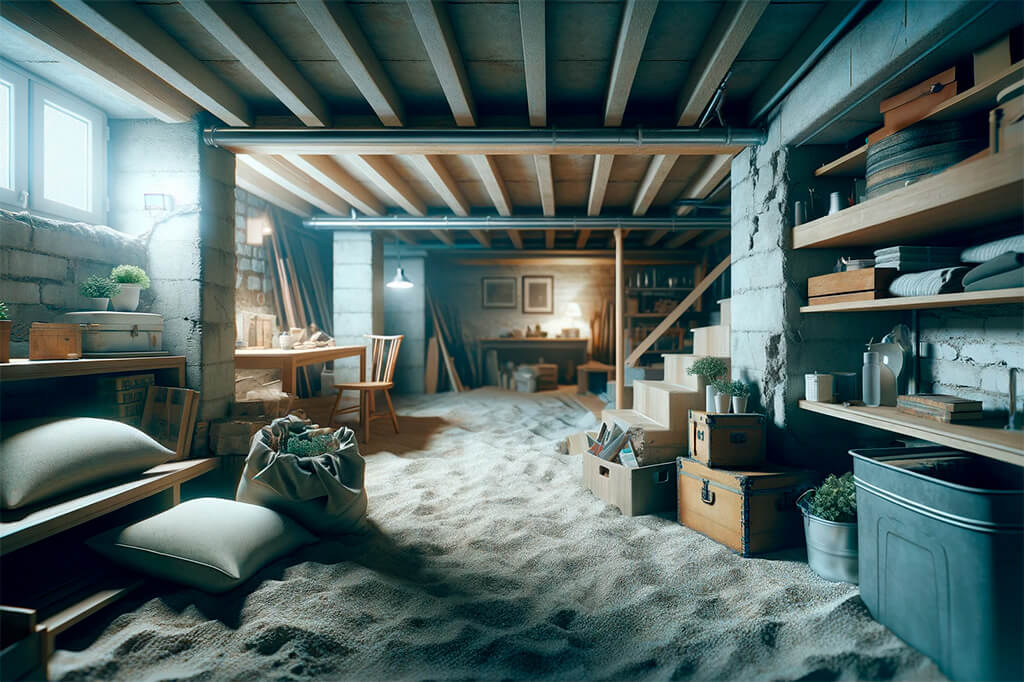Think of your basement walls as the foundation’s guardians. These walls are more than just underground structures, they’re the bedrock of your home’s integrity. Overlook them, and you might face everything from mildew to major structural issues. It’s not just about aesthetics – these problems can escalate into expensive and dangerous situations.
Cracks, leaks, and structural damage in basement walls are surprisingly common but often overlooked. A small crack might seem insignificant, but it can be an early warning sign of bigger issues brewing beneath the surface.

Understanding Basement Wall Problems
There are three primary types of basement walls: concrete, block, and stone. Each comes with its own set of challenges:
- Concrete Walls: Robust, yet susceptible to cracking, often due to shrinkage or external pressure.
- Block Walls: These can bow or buckle, especially if water drainage around the building is compromised.
- Stone Walls: They’re sturdy, but the mortar binding the stones can wear away over time.
Why do these problems arise? The main culprit is often water pressure – a constant force exerted by the surrounding soil. Compounded with issues like soil settlement or construction flaws, this can create significant problems for basement walls.
Diagnosing the Damage
Identifying the type of crack in your basement wall is crucial. Each kind tells a different story:
- Hairline Cracks: Commonly caused by the natural curing process of concrete or slight settling. Keep an eye on them, but don’t panic.
- Horizontal Cracks: These are more serious and could indicate that your wall is bowing under external pressure.
- Vertical Cracks: Often related to the house settling. Monitor them, but they generally aren’t as serious as horizontal cracks.
- Stair-Step Cracks: Typically seen in block walls, these can be a sign of significant issues, such as foundation movement.
It’s vital to distinguish between cosmetic and structural damage. Small, superficial cracks are usually cosmetic. However, if you notice doors that won’t close properly, floors that sag, or significant widening of cracks, these are signs of structural issues. In such cases, professional assessment becomes essential.

When to Call a Professional
Assessing when to tackle repairs yourself and when to call in a professional is crucial. For small, straightforward fixes, a DIY approach can be effective. However, for structural issues, persistent water intrusion, or if the problem is beyond your skillset, it’s wise to enlist a professional. This isn’t just about fixing a problem, it’s about safeguarding your home’s future integrity.
Preparation for Repair
Embarking on basement concrete wall repairs? First, let’s get you squared away with safety and prep. This isn’t just about fixing a wall, it’s about doing it without turning yourself into a renovation casualty.
- Safety Gear: The Non-Negotiables: Strap on your safety goggles, dust mask, and sturdy gloves. Contending with old walls can stir up a whole lot of nasties you don’t want in your lungs or eyes.
- Your Toolbox Checklist: Arm yourself with the essentials – a trusty chisel, a steadfast hammer, an agile trowel, and a reliable caulking gun. Oh, and if those cracks are out of reach, a ladder that doesn’t wobble is your best friend.
- Prepping the Battlefield: Clear the area. A stray tool or piece of rubble can be a real hazard. Next up, give those walls a good scrub down with a brush to remove loose debris. If you’re staring at years of build-up, a power wash might be in order.

Repair Techniques
Repairing cracks isn’t just about making things look pretty again, it’s about reinforcing the integrity of your home. Let’s break it down.
- Sealing Small Cracks:
- What You Need: For the minor stuff, get your hands on some epoxy or polyurethane foam.
- The How-To: Pry open that crack a tad with your chisel for better material penetration. Clean out the dust and debris, then get to filling it with your chosen sealant, using a caulking gun for epoxy. Follow the cure time to a T.
- Tackling Larger Cracks and Holes:
- The Approach: You’re looking at a concrete patching compound for the more noticeable gaps.
- Application Know-How: Undercut the crack edges to keep your patch in place. Mix your compound as per the guidelines and apply it with a steady hand using a trowel. Smooth it, then leave it to set completely.
- Combatting Dampness and Leaks:
- Quick Fixes: First, ensure water isn’t pooling around your foundation. Gutters and landscaping should lead water away, not towards your house.
- Sealing the Deal: For damp walls, waterproofing sealants can work wonders. In more severe cases, consider an interior drainage system or a sump pump installation.
Structural Repairs
When your walls are crying out for more than just cosmetic touch-ups, it’s time to look at structural solutions.
- When to Bulk Up Your Walls:Keep an eye out for bowing walls or horizontal cracks – these are your SOS signals.
- Bracing the Walls:
- Carbon Fiber Straps: These are your go-to for halting wall movement. They’re strong yet unobtrusive and easier to install than you might think.
- Steel I-Beams: When things are dire, these are your heavy artillery. They’re set vertically against the wall and anchored solidly. It’s a big job, but it’ll shore up those walls like a fortress.
- DIY or Dial a Pro?:
- Going Solo: If you’re dealing with minor repairs and feel confident, dive in. There’s a certain satisfaction in patching up your own walls.
- Calling in the Cavalry: Structural issues? Don’t play the hero. Get a professional. This is about your home’s backbone, and you want that as strong as can be.

Finishing Up
After diligently repairing those basement walls, it’s imperative to focus on the finishing touches, which are critical for long-term durability and aesthetic appeal.
- Effective Waterproofing: Applying a high-quality waterproofing sealant over the repaired area is crucial. This step ensures that moisture, a primary cause of basement wall damage, is kept at bay. A uniform application is key for maximum effectiveness.
- Achieving a Polished Look: For those desiring a visually pleasing finish, a coat of masonry paint or a concrete sealer is recommended. This serves a dual purpose – enhancing the appearance while adding an additional protective layer against elements.
- Ongoing Maintenance: Regular inspection and maintenance of the basement walls cannot be overstressed. Look out for new signs of damage, such as cracks or moisture, and ensure that external factors like gutter cleanliness and proper yard grading are maintained to prevent water accumulation near the foundation.
FAQ Section
While small cracks might seem inconsequential, they often signal larger issues. Regular monitoring is essential, as neglect could escalate into more significant repairs down the line.
Horizontal cracks typically indicate a structural problem. Strengthening the wall with carbon fiber straps or steel I-beams is often necessary to ensure the wall’s integrity and prevent further damage.
Evaluate the extent of the damage. Minor cracks or slight dampness might be within the ambit of a skilled DIY enthusiast. However, significant structural issues, widening cracks, or extensive water leakage warrant professional assessment and intervention.
Proactive maintenance is key. Ensuring proper external drainage, conducting regular inspections, and addressing minor issues promptly can mitigate the risk of major basement wall problems.
For smaller cracks, epoxy or polyurethane injections are effective. They provide a robust seal. For larger gaps, hydraulic cement is recommended due to its expansive properties and strength.
